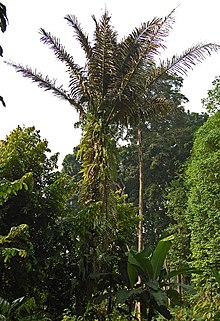Arenga
| Arenga | |
|---|---|

| |
| Arenga pinnata | |
| Scientific classification | |
| Kingdom: | Plantae |
| Clade: | Tracheophytes |
| Clade: | Angiosperms |
| Clade: | Monocots |
| Clade: | Commelinids |
| Order: | Arecales |
| Family: | Arecaceae |
| Tribe: | Caryoteae |
| Genus: | Arenga Labill. ex DC. |
| Synonyms[1] | |
| |
Arenga is a genus of palms, native to Southeast Asia, southern China, New Guinea, and northern Australia.[1][2] They are small to medium-sized palms, growing to 2–20 m tall, with pinnate leaves 2–12 m long.[3][4] Arenga palms can grow in areas with little sunlight and relatively infertile soil.[5]
Species[]
- (H.Wendl. & Drude) S.T.Blake ex H.E.Moore – Queensland
- Becc. – Sumatra, Borneo
- (Lour.) H.E.Moore – Guangxi, Hainan, Indochina
- Mogea – Borneo
- Arenga engleri Becc. – Taiwan
- (Becc.) Whitmore – Thailand, Malaysia, Borneo, Sumatra
- Arenga hookeriana (Becc.) Whitmore – Thailand, Malaysia
- Arenga listeri Becc. – Christmas Island
- C.F.Wei – Guangdong
- Mogea – Sumatra
- Arenga micrantha C.F.Wei – Tibet, Bhutan, Arunachal Pradesh
- Becc. in K.M.Schumann & U.M.Hollrung – Maluku, New Guinea, Northern Territory of Australia
- Becc. – Mindoro
- Mart.- Thailand, Malaysia, Borneo, Java
- Arenga pinnata (Wurmb) Merr. – Assam, Indochina, Philippines, Sulawesi; naturalized in southern China, Benin, Maluku, New Guinea, Hawaii
- Mogea – Sumatra
- (Blume ex Mart.) H.E.Moore – Java, Sumatra
- H.E.Moore & Meijer – Sabah
- A.J.Hend – Ryukyu Islands
- Mogea – Sumatra
- (Blanco) Becc. – Philippines
- Becc. – Borneo, Palawan, Sulawesi
- Arenga westerhoutii Griff. – southern China, Indochina, Assam, Arunachal Pradesh, Bhutan
- Arenga wightii Griff. – India
References[]
- ^ a b Kew World Checklist of Selected Plant Families
- ^ Flora of China, Vol. 23 Page 151, 桄榔属 guang lang shu, Arenga Labillardière, Bull. Sci. Soc. Philom. Paris. 2: 162. 1800.
- ^ Govaerts, R. & Dransfield, J. (2005). World Checklist of Palms: 1–223. The Board of Trustees of the Royal Botanic Gardens, Kew.
- ^ Henderson, A. (2009). Palms of Southern Asia: 1–197. Princeton university press, Princeton and Oxford.
- ^ "The Amazing Arenga Sugar Palm | Reuters".
Categories:
- Arenga
- Flora of Indomalesia
- Arecaceae genera
- Palm stubs

